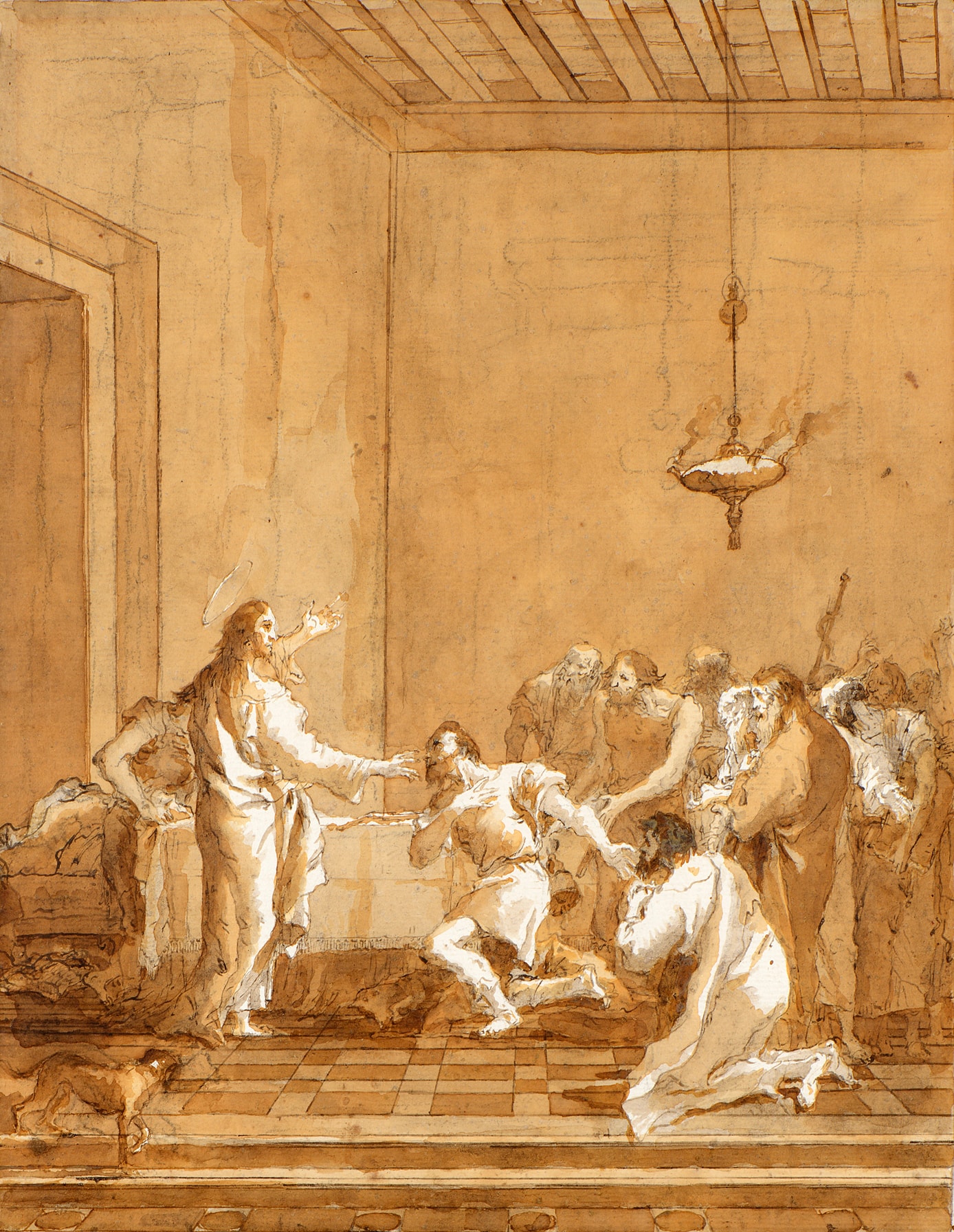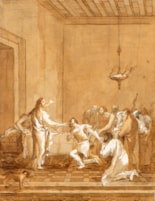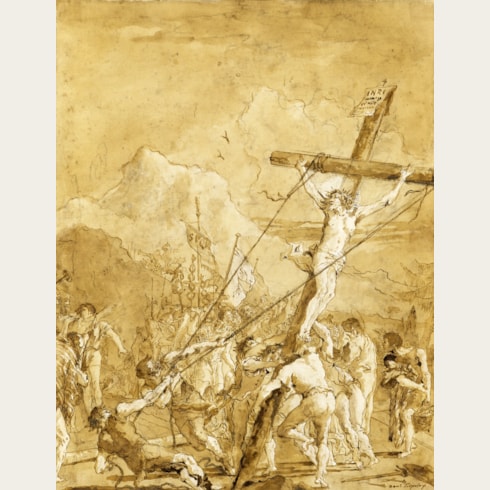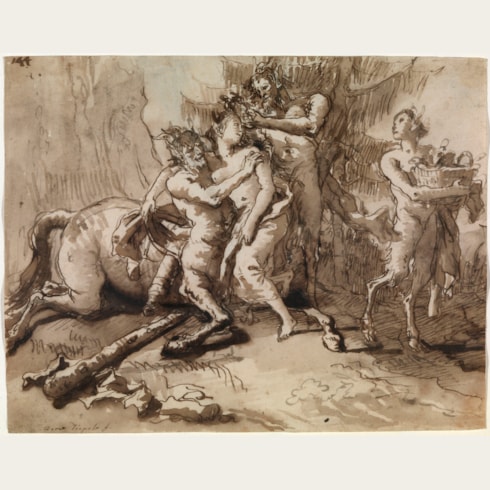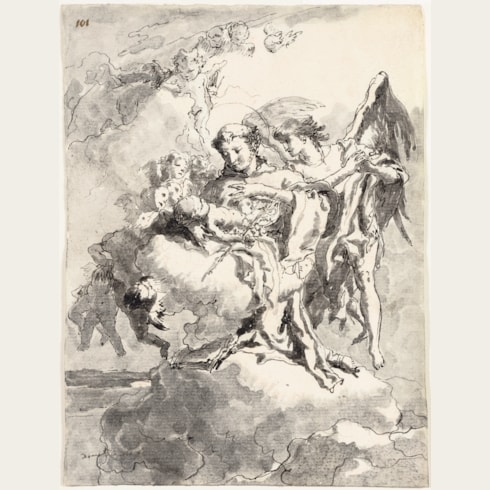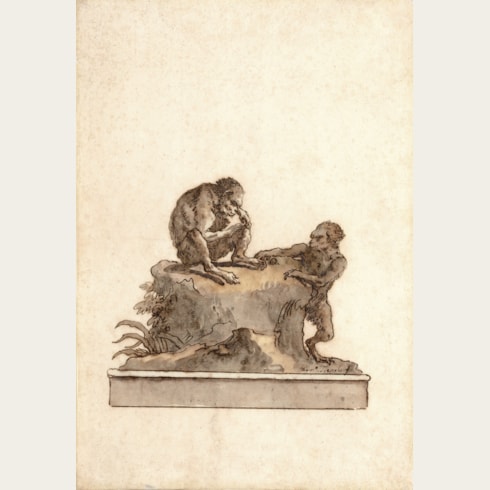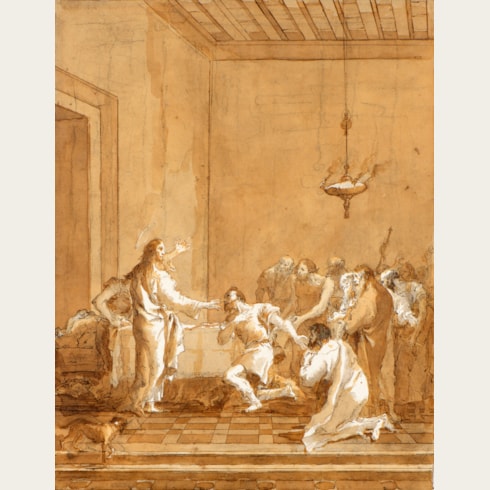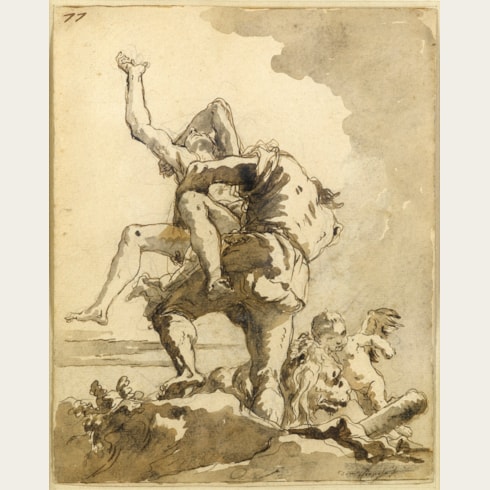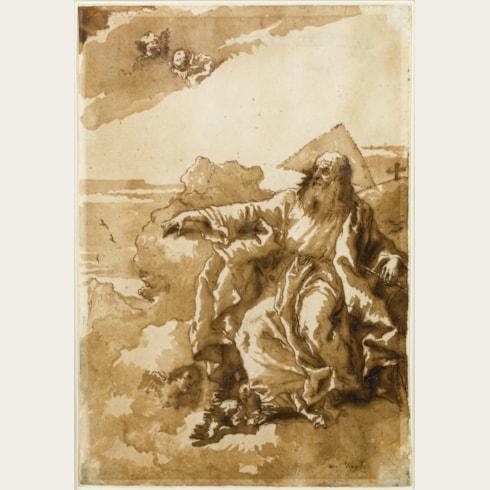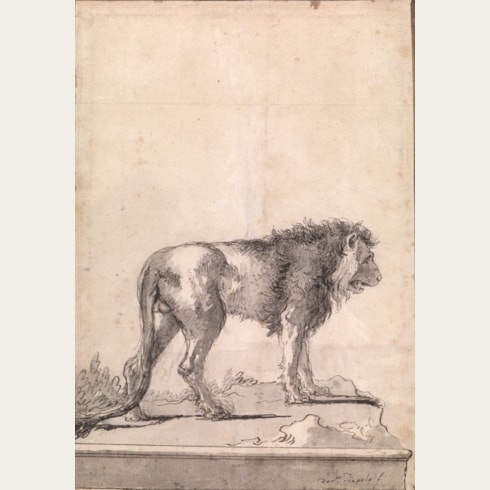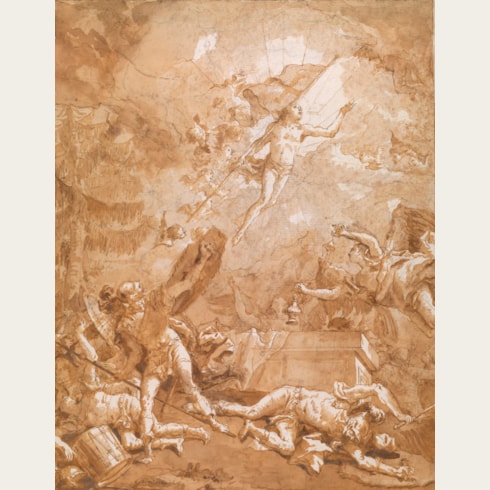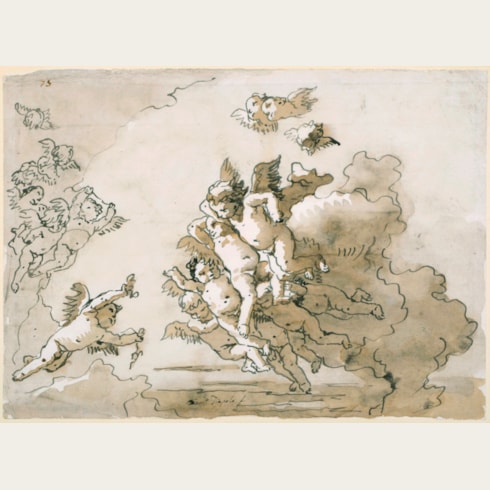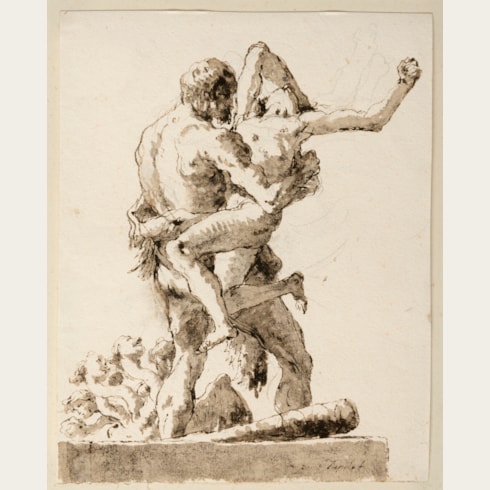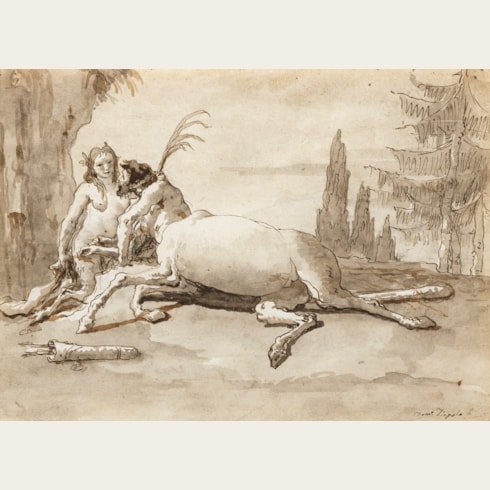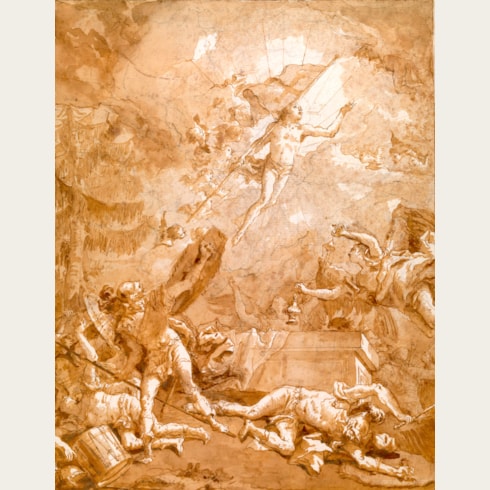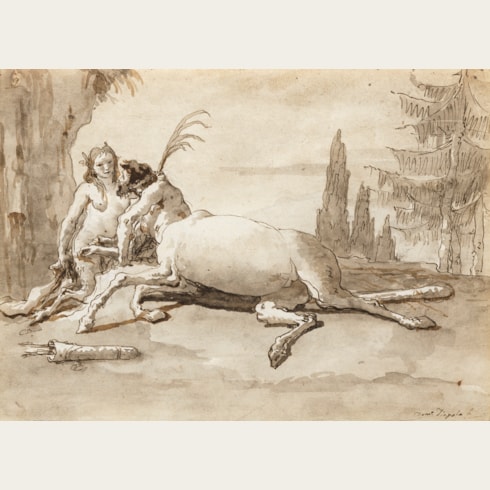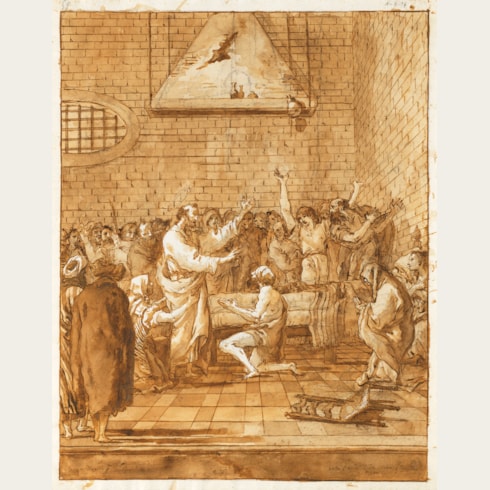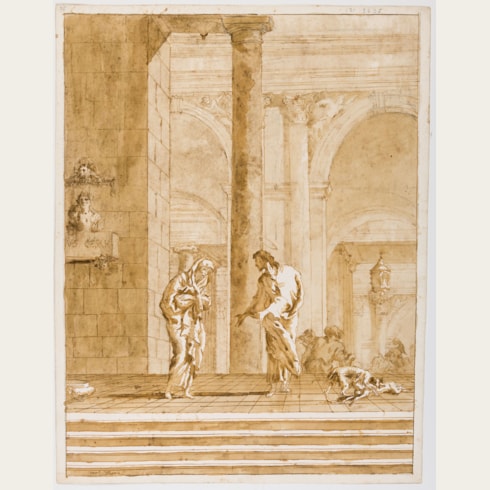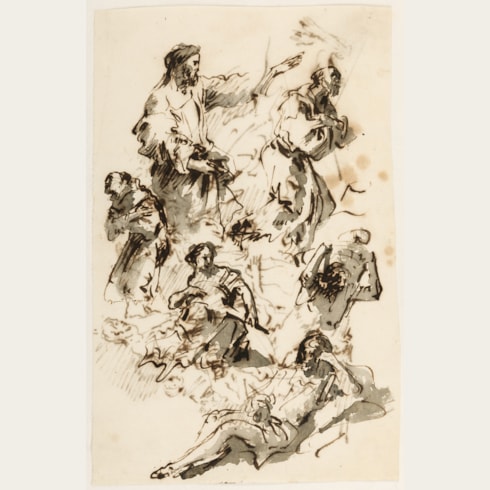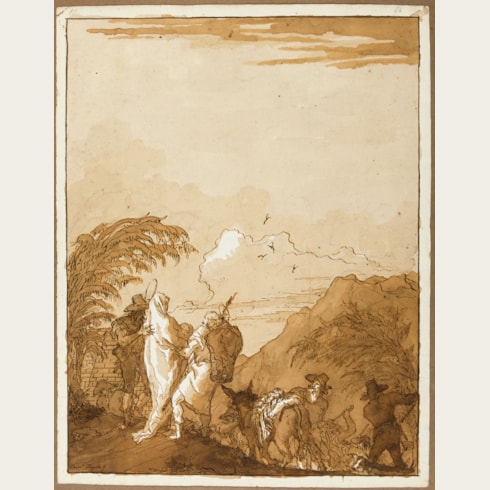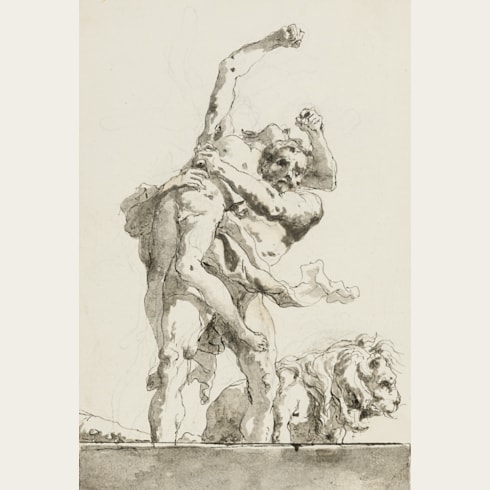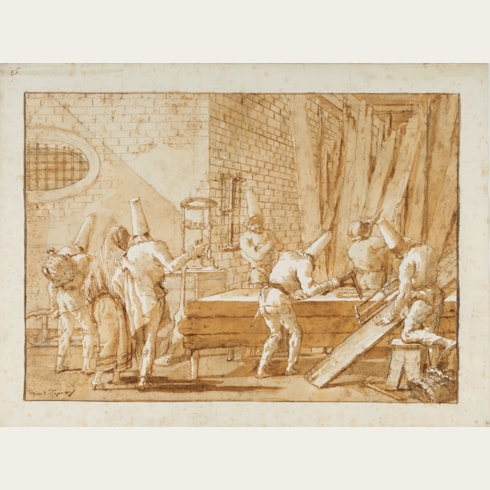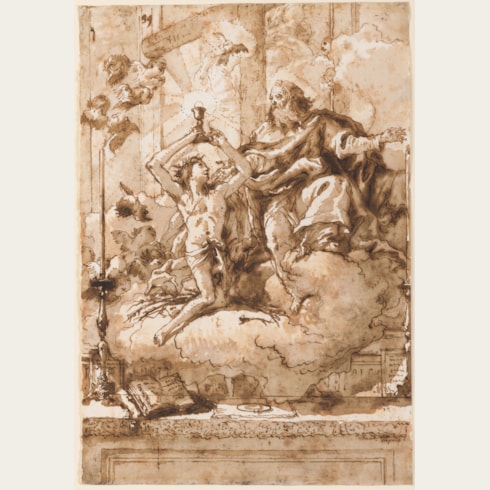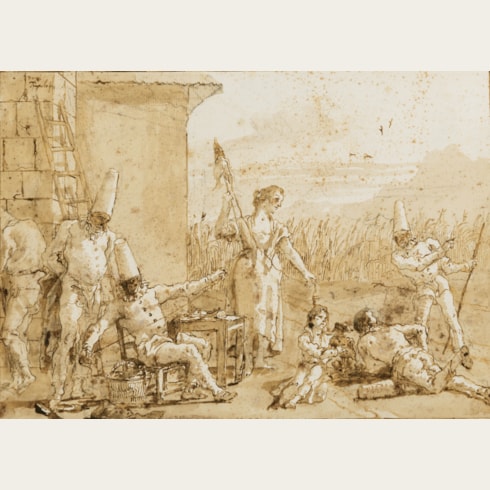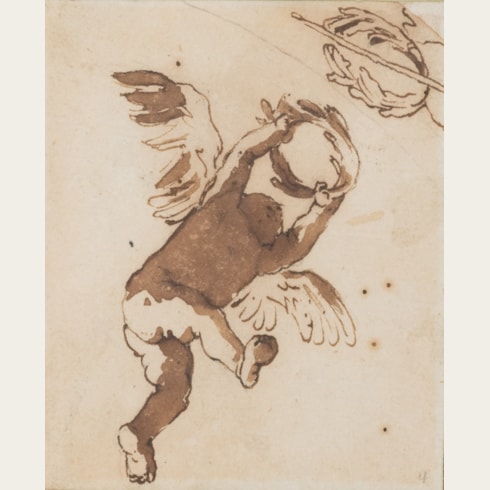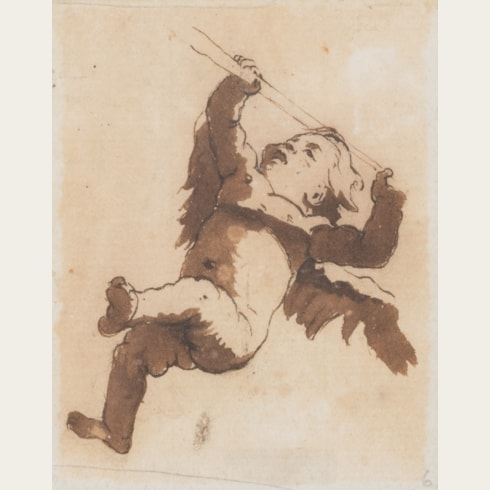Giovanni Domenico TIEPOLO
(Venice 1727 - Venice 1804)
Christ Warns Peter in the Upper Room
484 x 375 mm. (19 x 14 3/4 in.) [sheet]
The drawings of the ‘Large Biblical Series’ (also known as the New Testament series) are among Domenico’s most ambitious and inventive works as a draughtsman. As the Tiepolo scholar Adelheid Gealt has noted of this group, ‘All vertical in format, often with lavish landscape or architectural settings, the drawings are the most exhaustive exploration of biblical subjects by a single eighteenth-century artist. Even in the context of Italy, where the traditions of religious painting remained very much alive despite the impact of the Enlightenment, Domenico’s sustained fascination with biblical subjects is extraordinary, particularly since it is assumed that he drew them primarily to please himself, rather than at the behest of an ecclesiastical patron.’
The subject of this drawing is taken from the Gospels, and depicts Christ and his disciples in the upper room, or Cenacle, in Jerusalem, where the Last Supper was held. Before Jesus led the disciples to the Mount of Olives, he told the apostle Peter that he would soon come to deny him: ‘And the Lord said, Simon, Simon, behold, Satan hath desired to have you, that he may sift you as wheat: But I have prayed for thee, that thy faith fail not: and when thou art converted, strengthen thy brethren. And he said unto him, Lord, I am ready to go with thee, both into prison, and to death. And he said, I tell thee, Peter, the cock shall not crow this day, before that thou shalt thrice deny that thou knowest me.’ (Luke 22: 31-34)
The bold composition of this drawing, with much of the upper part of the sheet left empty apart from a hanging oil lamp, is a characteristic of many of the works from the ‘Large Biblical Series’. As evidenced by the visible underdrawing in black chalk, the lamp was originally placed slightly higher and more to the left, and by bringing it closer to the gathered apostles the artist was able to create a more dramatic effect, casting a powerful light on Christ and the two apostles kneeling before Him. The rich, golden tone of the washes – a characteristic feature of the ‘Large Biblical Series’, though not always seen with such freshness as in the present sheet - is contrasted by areas where the surface of the paper has been left untouched to create brilliant highlights, as on the draperies of Christ and the two kneeling figures.
It remains a mystery why Domenico Tiepolo embarked on this sequence of well over three hundred large and finished drawings, which do not appear to have been commissioned by any particular patron and, like the Divertimenti per li regazzi series of Punchinello subjects, seem to have been conceived as a complete and unified narrative ensemble. While the vertical format of the drawings has led to the suggestion that they may have been intended as book illustrations, the fact that most of the compositions are signed would seem to indicate that they were regarded by the artist as independent, finished works. As Byam Shaw describes them, ‘They are essentially 'album drawings', intended not as studies for painting or etching, but as works of art in their own right; and they belong to a period when drawing, rather than painting, was Domenico’s chief occupation.’
In the drawings of the ‘Large Biblical Series’, the artist ‘pondered the visual and literary history of his own faith, producing his largest and most ambitious serial – some 320 drawings that took a new and very different approach to this venerable theme. Culling both visual and textual sources, Domenico undertook what amounts to his own documentation of [the] Catholic faith.’ Furthermore, as Gealt has pointed out, ‘The son and pupil of one of Europe’s most sophisticated painters and the brother of a priest, Domenico...was uniquely qualified for his New Testament, which aligned itself so beautifully with his predilection for pictorial serial narrative and sacred stories. It is not difficult to imagine Domenico working at a fairly large table, with an abundance of large, uncut sheets of thick paper to hand, inks, chalks, and pen at the ready, and a vast amount of visual and textual knowledge in his head.’
Like the other two late series of drawings that the artist produced at the end of his career, namely the ‘Scenes from Contemporary Life’ and the Punchinello series, the artist seems to have kept the drawings of the ‘Large Biblical Series’ in his studio until his death. Probably done for his own pleasure, without any underlying commercial purpose, they are perhaps best regarded as a labour of love on the part of this deeply devout artist; ‘a work of personal piety,...[and] truly a summation of his forty years of distinguished work as a painter of religious subjects.’
The present sheet was one of fifty-nine drawings from the ‘Large Biblical Series’ selected for a remarkable exhibition devoted to the series, held at the Frick Collection in New York in 2006-2007; an event which provided a rare opportunity to see, displayed together, some of the finest drawings in the sequence. As Gealt has written, ‘While each drawing is a masterpiece of composition and draftsmanship, its real value, as part of an unfolding narrative with rich visual connections to other drawings in the series, can only be appreciated when viewed in its original context.’
Giovanni Domenico Tiepolo is assumed to have begun his career in the family studio by copying his father’s drawings, although he also created his own drawings as designs for etchings, a practice which occupied much of his time in the 1740s and 1750s. His first independent drawings for paintings are those related to a series of fourteen paintings of the Stations of the Cross for the Venetian church of San Polo, completed when he was just twenty. Between 1750 and 1770, Domenico worked closely with his father as an assistant, notably in Würzburg, at the Villa Valmarana in Vicenza and the Villa Pisani at Strà, and in Madrid. From the late 1740s he also began to be entrusted with his own independent commissions, and the drawings for these display a manner somewhat different from that of his father, with a particular interest in lighthearted genre motifs.
Soon after Giambattista Tiepolo’s sudden death in Madrid in 1770, Domenico returned to his native Venice, where he enjoyed much success as a decorative painter. He continued to expound the grand manner of history painting established by his father - the ‘Tiepolo style’, as it were – and by 1780 his reputation was such that he was named president of the Accademia di Belle Arti in Venice. Within a few years, however, he seems to have largely abandoned painting. In his sixties and living effectively in retirement at the Tiepolo family villa at Zianigo, on the Venetian mainland, he produced a large number of pen and wash drawings that are a testament to his inexhaustible gift for compositional invention.
For much of the last twenty years of his career, Domenico Tiepolo seems to have painted only occasionally, and instead worked primarily as a draughtsman, producing a large number of pen and wash drawings that may collectively be regarded as perhaps his finest artistic legacy. These drawings were, for the most part, executed as a series of several dozen or more themed drawings, many of which were numbered. Among these are several series of drawings of religious and mythological subjects, as well as a varied group of genre scenes, numbering around a hundred sheets, generally referred to as the so-called ‘Scenes of Contemporary Life’, and a celebrated series of 104 drawings entitled the Divertimenti per li regazzi, illustrating scenes from the life of Punchinello, a popular character from the Commedia dell’Arte.
Domenico’s highly finished late drawings, almost all of which were signed, were undoubtedly intended as fully realized, autonomous works of art. While it is certainly possible that they were produced as works of art to be offered for sale to collectors, almost none of the drawings appear to have been dispersed in Domenico’s lifetime. The fact, too, that many of the drawings are numbered, possibly by the artist himself, and that most remained together in groups for many years after his death, would also suggest that they were retained in his studio throughout his life, as indeed he also kept numerous albums of drawings by his father. It is most likely, therefore, that these late drawings by Domenico were done simply for his own pleasure. Nevertheless, they have consistently enjoyed immense popularity since the artist’s death, and continue to entice collectors today. As Catherine Whistler has noted, ‘Domenico’s spirited and inventive independent sheets have long been appreciated, particularly by French and American collectors of the late nineteenth and early twentieth centuries; his quirky sense of humor, acutely observant eye, and zestful approach to his subjects lend his drawings a peculiarly modern appeal.’
As Michael Levey has also noted of the artist, ‘Domenico Tiepolo’s drawings provide us with the more private side of him, but they also serve to represent his career at all stages. He drew continually: sometimes very closely in the manner of his father; at the opposite remove, in the late Punchinello drawings for example, his manner and matter could never be mistaken for anyone else’s...The key to Domenico is in drawings: he began as a draughtsman and, one is tempted to say, all his paintings betray the draughtsman.’
Provenance
Literature
Exhibition

